15 Weird Trees Around The World
You can find unusual types of trees all over the world. The more unique
types, though, go largely unnoticed. The reason? Because trees are so common, we
fail to recognize and think about them too much. Trees are classified as woody
perennial plants that are taller than shrubs. However, that definition
encompasses thousands of unique tree species that grow all over the world.
Tree of Life Located in Bahrain, Australia:
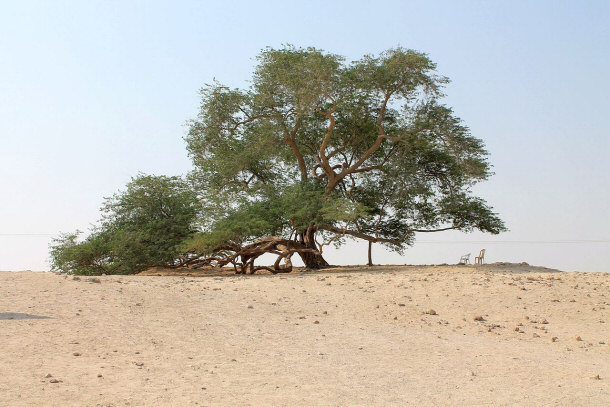
By Alawadhi3000
via Wikimedia Commons
But what might seem odd or unusual in your part of the world might be common
place somewhere else. There are many regions in the world that foster tree
species that are unique to that region alone. Other times, trees will seem to
defy nature and grow into some kind of structure that becomes a spectacle, which
scientists are unable to understand. Many of the weirdest trees in the world
have become tourist attractions as well as mythological structures. Interesting
tree species exist all over the world and are adored and awed as rarities of
nature.
15) The Chandelier Tree
Along the California coast, 175 miles north of San
Francisco, is the Drive Thru Tree Park in Leggett, California. In this park,
visitors are able to drive through the trunks of tall Coast Redwood trees. The
most famous tree of the drive-thru is the Chandelier Tree.
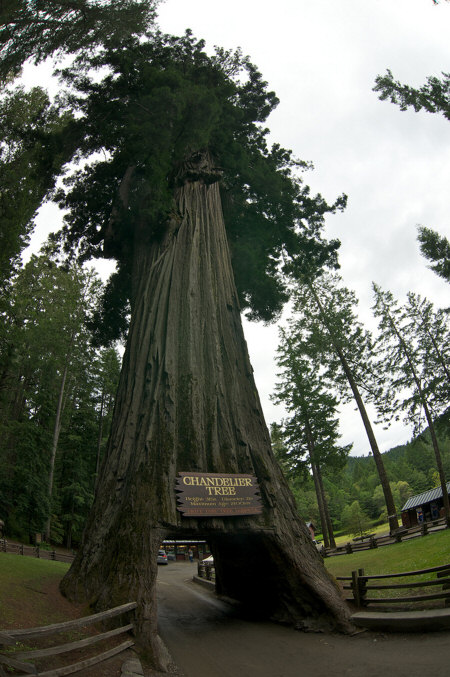
The Chandelier Tree is 315 feet tall. It is part of the Sequoia species and
goes by the common name of Coast Redwood, or California Redwood. Cars are able
to pass through the tree, which has a clearance of 6 feet, 9 inches tall, and is
6 feet wide.
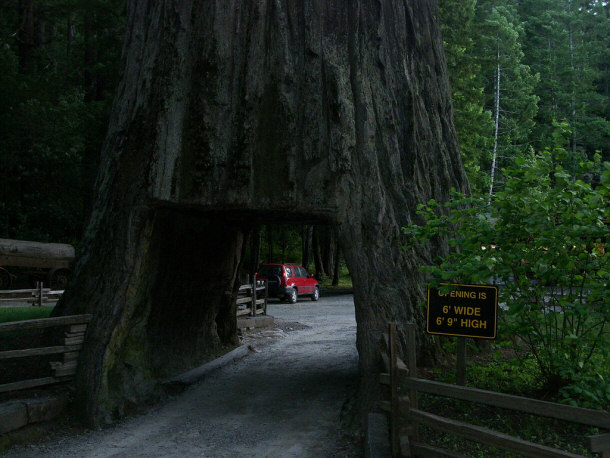
In the 1930s, the hole was carved out of the bottom of this tree,
as well as many similar ones. It got its name from the enormous branches
balancing out on both sides of the trunk. These trunks are "L" shaped and the
size of small trees. It looks like a candelabra, but from an upside-down point
of view, it resembles a chandelier. And if your car can fit under the tree, you
can have a little picnic there. The park costs $5 per car, and there's even a
gift shop in the 250-acre park.
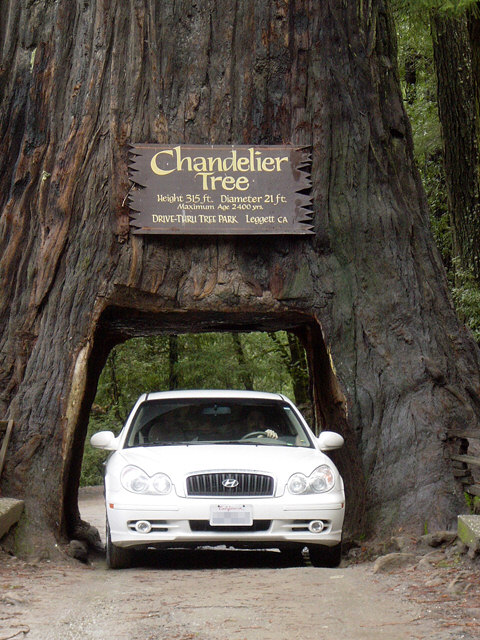
By Bobak Ha´Eri
via Wikimedia Commons
Coast Redwood trees are some of the tallest trees in the world, according to
National Geographic. Although the Chandelier Tree is not the tallest tree on
earth, it shares the same species with the tallest tree. The park attracts many
visitors each year. Fans of the 1983 film "Nation Lampoon's Vacation," may
recall that the opening credits featured a photograph of the Chandelier Tree.
14) The Circus Trees
Many trees have grown to become wonders on their own,
without the influence of humans. However, humans are able to transform trees
into spectacular structures. In the 1920s, bean farmer Axel Erlandson began
grafting and weaving Sycamore trees. By using several Sycamore trees, Erlandson
created incredible new tree structures. His first was called the "Four-Legged
Giant." Using four Sycamores, he grafted and weaved the trees to create shapes
like hearts, lightning strikes, and rings. One of the most famous Circus Trees
is a honeycomb-like tube structure that was grown out of six Sycamore trees.
Axel Erlandson and His"Four-Legged Giant":
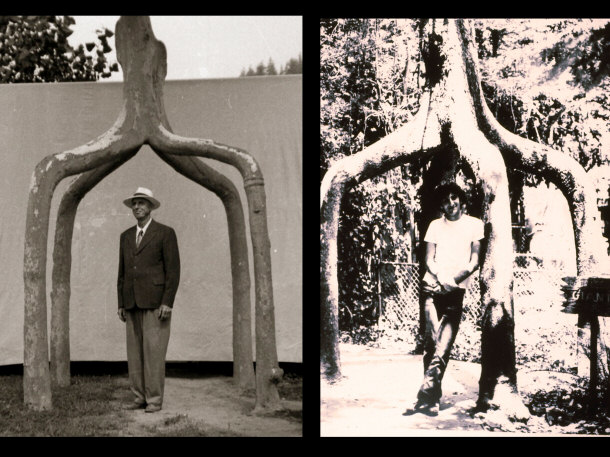
Erlandson's Circus Trees are situated at Gilroy Gardens, California.
According to the Gilroy Gardens website, Erlandson spent 40 years turning
Sycamore trees into over 70 works of art. The pieces were left unkempt in the
1970s after the land's owner died, but most were saved. In the 1980s the trees
found a home at Gilroy Gardens, which is also a family theme park.
Erlandson Two-Leg or rather Trunk, Tree:
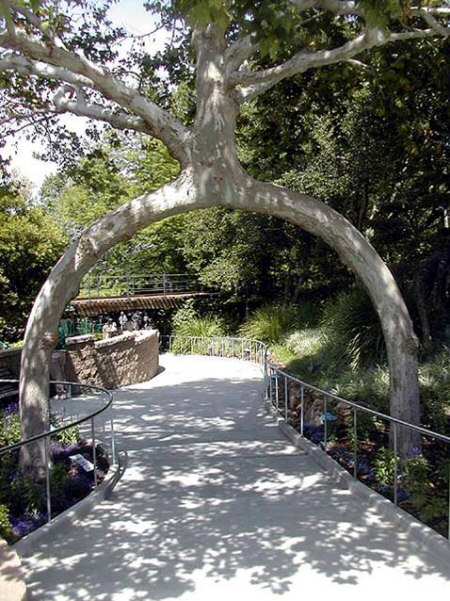
By Vladi22
via Wikimedia Commons
The park
celebrated its 10th anniversary in 2010, and these days, you can find everything
from a roller coaster to several restaurants.
"Basket Tree":
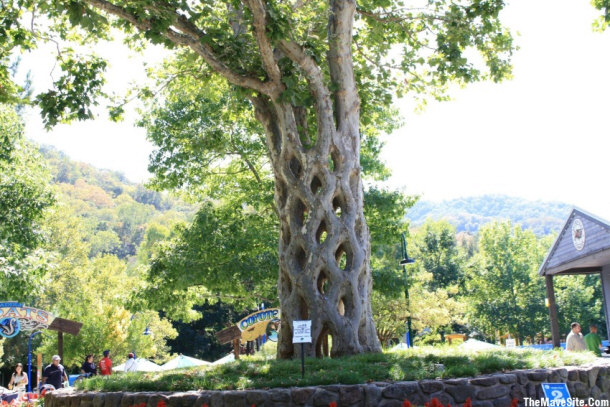
"Cube Tree":
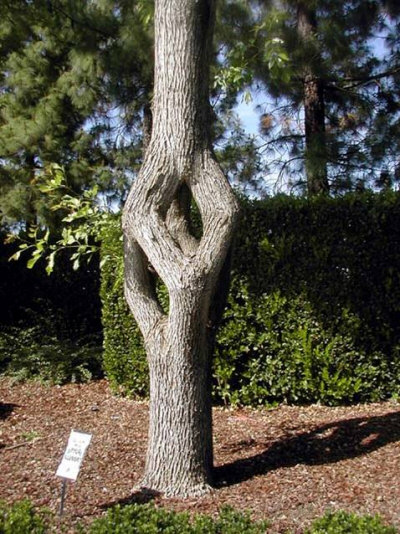
By Vladi22
via Wikimedia Commons
13) The Tree of Life
The motif of the Tree of Life is seen in religion,
science, and mythology. It represents the interconnectedness of all life on
earth, as well as the evolution of creation throughout life. A Mesquite tree in
Bahrain is known as the Tree of Life. It is a unique and mystical phenomenon
because it has been able to survive without a known water source for over 400
years. The area in Bahrain is deserted and completely free of water sources. It
is located in the middle of the desert, more than two kilometers away from Jebel
Dukhan, the highest point in Bahrain.
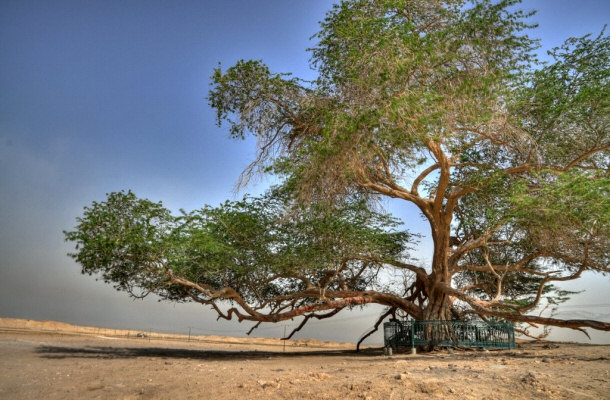
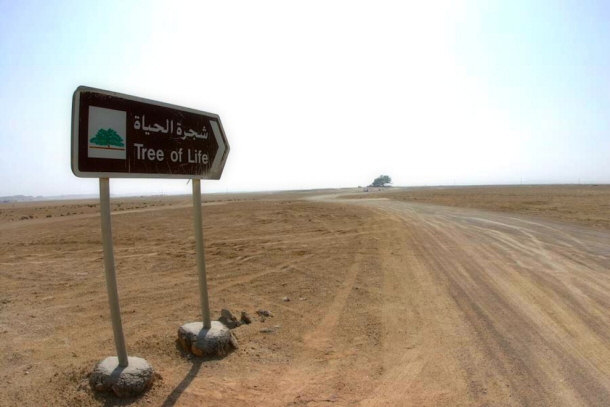
The New 7 Wonders Foundation has categorized the Tree of Life as one of the
New Seven Wonders of Nature. The tree is 32 feet tall, and is also a World
Heritage Site, according to UNESCO. It sits atop a 25-foot tall hill. No
scientists have been able to figure out where the tree gets its water supply
from to continue surviving. Along with mysterious nature of the tree, and its
mythical value, local inhabitants of Bahrain believe that the tree could beat
the actual location of the Garden of Eden. It attracts over 50,000 tourists
every year. According to the Gulf Daily News, the tree is often vandalized with
graffiti and carvings. Some of this vandalism is thought to be ancient rites of
various theological sects.
12) The Chapel Tree
The most famous tree in France is the Chapel Tree. It is
called the Chaple-Oak of Allouville-Bellefouse, which the small town in northern
France where the tree-chapel is located. Today the tree is almost 1,000 years
old. Although its precise age is unknown, it is still among one of the oldest
trees in the world. It stands at over 50 feet high, and has a based
circumference of about 50 feet as well. In 1669, when the tree was about 500
years old, Abbot Du Detroit and Father Du Cerceau decided to transform the tree
into a chapel. This was after lightning strike hit the tree, and hollowed it out
with a fire within the tree. As a tribute to the Virgin Mary, the tree was used
as a pilgrimage location.
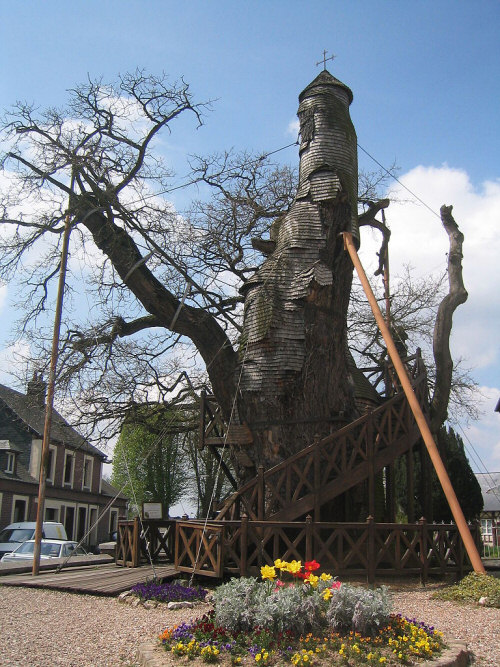
By Ji-Elle
via Wikimedia Commons
Today, there are two chapels located in the tree: Our Lady of Peace, and the
Hermit's Room. A spiral staircase surrounds the tree, allowing people access to
the chapels. It is the oldest known tree in France. Due to its old age,
protective shingles now protects the tree. Visitors and locals still use the
tree's chapels as a place of worship. During the French Revolution, the tree was
almost burned down, as a protest against the power of the church on the state.
To protect it, the chapel was briefly renamed the "temple of reason" to appease
the values of the enlightenment, according to Atlas Obscura. Each year, the
Chapel Tree still serves as a pilgrimage location on August 15, for the Feast of
the Assumption of the Virgin.
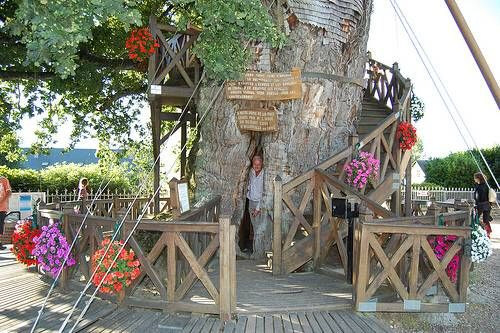
11) Ta Prohm Trees of Cambodia
The Angkor region of Cambodia is known as the
nation's holy temple region. Within this jungle region is the Silk Cotton trees
of the Ta Prohm Buddhist temple. The temple was built in the 12th century, and
is now considered to be ruins. The trees were left to grow naturally over the
temple for hundreds of years. As a result, they grew over the temple, winding
themselves around the outside walls of the structure. Today the location is
called the Angkor Archaeological Park.
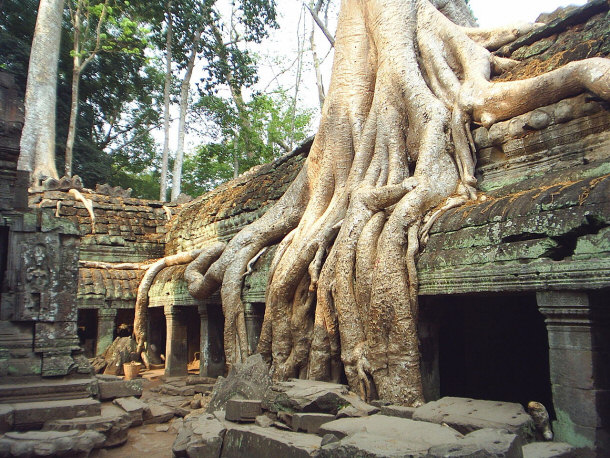
By Markalexander100
via Wikimedia Commons
The Silk Cotton tree's trunks sprawl over
the ground, growing up over the temple walls. Over top of the temple, the trees
provide a leafy green canopy. The temple and the silk-cotton trees are on the UNESC World Heritage Site list. Along with the Silk Cotton trees, Strangler Fig
trees also grow around the temple. The temple and the trees have been protected
and restored in a way to maintain the natural and somewhat neglected appearance
of the holy location, according to Maurice Glaize, an Angkor scholar.
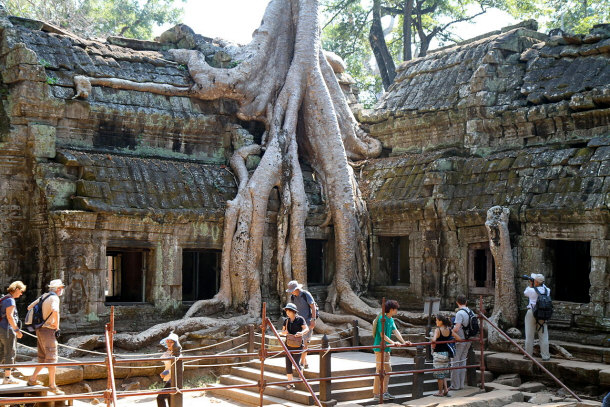
By Jasoneppink
via Wikimedia Commons
The location attracts thousands of tourists traveling through Southeast Asia.
It can also be recognized as a prominent filming location of the "Tomb Raider"
film. If visiting the Ta Prohm Trees, tourists will likely be encountered by
local children who avoid security to offer tours, according to Lonely Planet.
The tourist travelers' guide recommends visitors avoid doing this.
10) Teapot Baobab Trees
Baobab trees are a species that is native to
Madagascar, as well as Australia and Africa. The trees of Madagascar as called
"Teapot Baobabs," as they grown from ponds in the ground. Baobab trees grow wide
and tall and have one of the longest survival rates of any tree species. On
average, the trees grow to be up to 100 feet tall. However, it is the width of
the Baobab trunks that is so amazing. Most trunks reach diameters of about 30
feet. Most of the year, the Baobab remains leafless. Sometimes they are called
upside down trees, because their leafless trunks stick up high in the air.
Teapot Baobab:

Image by Gail Hampshire
In Africa, the Baobab tree is sometimes called the tree of life. However,
this is not for spiritual or theological reasons. The tree is so useful, that it
is able to help sustain life in many ways. Baobabs provide food, a fruit called
"Monkey Bread", according to BBC Nature. The fruit provides people with a
sustainable source of vitamin C. Scientists think that the Baobab tree could be
a potential answer to major world health problems, according to Biodiversity
International. Baobab bark is used to make rope and cloth, to use as tools or
clothing. In addition to all these uses, Baobab trunks also serve as shelter.
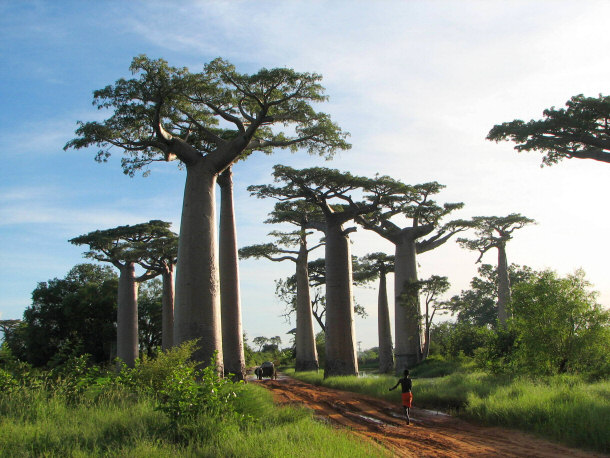
By Bernard Gagnon
via Wikimedia Commons
People are able to make homes in the hollowed out trunks of the Baobab tress.
These trees live for thousands of years. Age makes the trunks naturally hollow
out. The most famous Baobab tree is called the "Big Baobab." There is a pub
built inside of it that can seat up to 60 people. The Baobab is also phenomenal
because the trunk is quite fire resistant, because it stores a large water
supply to sustain it throughout the dry months of the year.
Big Baobab Trees Located in the Limpopo Province, South
Africa:
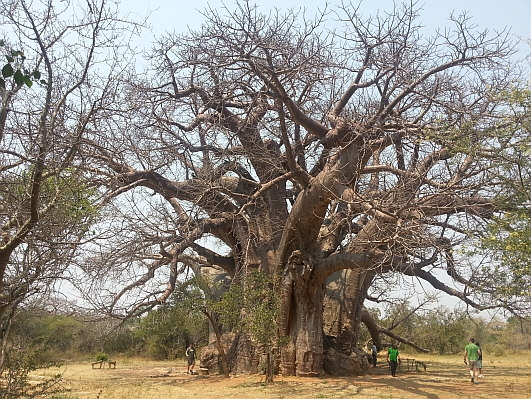
By Scott Davies
via Wikimedia Commons
The Pub inside "Big Baobab"
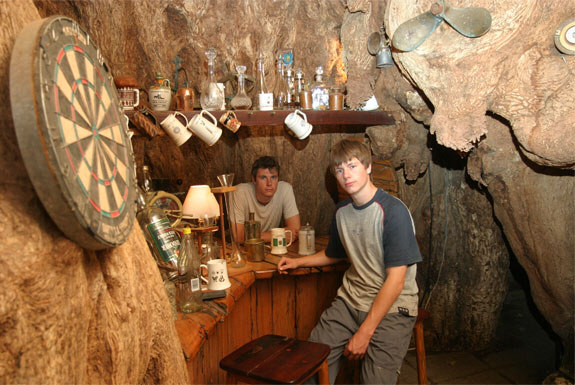
9) The Baobab Prison Tree
The Baobab Tree is also native to Australia, in
addition to growing in African regions. One of the strangest Baobab trees still
standing today is the Western Australian Baobab Prison Tree. Throughout the
1890s many Baobab trees were used as temporary prisons, due to their wide
hollowed out trunks. There are prison trees throughout Australia, especially in
the Wyndham region. The Wyndham region Baobab trees were named the Hillgrove
Prison Trees. According to a 1931 article in the Australian National Archives,
the prisons would hold up to 30 aboriginal prisoners at a time, although some
prisoners would have to remain outside of the trunk in chains. The trees look
like a wide bulb with several branches coming out of the top.
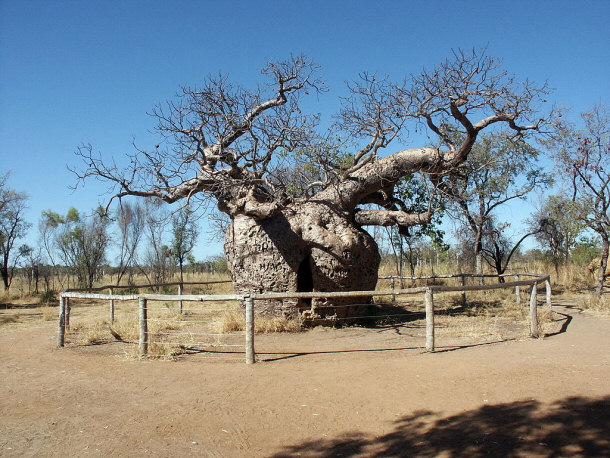
By Nachoman-au
via Wikimedia Commons
Another famous, yet misconceived, prison tree was located near Derby,
Australia. It was thought that it was used as a temporary prison, prior to
arriving in Derby for sentencing. Derby is a town slightly North of the famous
Baob Prison Tree. According to a 1966 article entitled "Dance of the Boabs,"
which is also kept at the Australian National Archives, there were never any
prisoners actually kept at the Derby tree. Both the Derby Prison Tree and the
Hillgrove lockup of Wyndham, are kept as tourist attractions today. The
Hillgrove Prison Tree has been used as a tourist destination since the early
1900s, only years after it was used as a functioning prison cell.
8) Dragon Tree
On one of the Canary Islands, located off the Northwestern
coast of Africa, is the location of the world famous Dragon Tree. The tree has a
wide based, narrow center, and a wide crown of buds. It looks like hundreds of
smaller trees, growing as one, are tied together in the middle. According to the
Tenerife region website, the island where the tree grows, legends says that when
a dragon dies, it becomes a tree. This is why dragon trees are considered living
fossils. On the Tenerife Island, is a tree that some speculate is up to five
thousand years old. However, studies in the late 20th century have shown that
the tree is only about a few centuries years old. It is about over 50 feet tall,
and 65 feet wide at the base. It bleeds a red sap when it is cut.
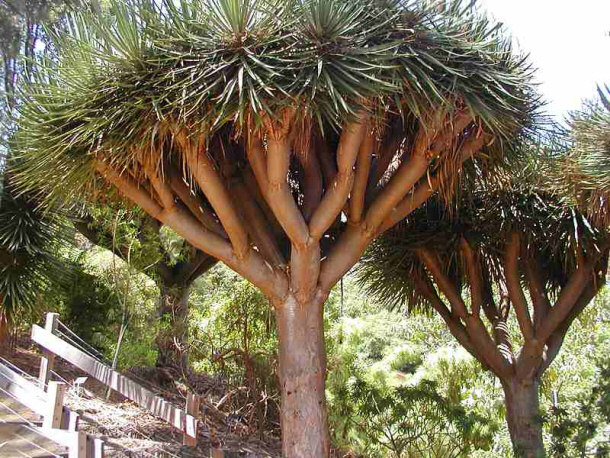
The tree is significant in Greek mythology. It is associated with the myth
"The Eleventh Labor of Hercules," according to the Global Trees Campaign.
According to the myth, Hercules had to kill the hundred-headed dragon in order
to fulfill his task of bring back three golden apples from the Garden of the
Hesperides. The Dragon Trees red sap is symbolic of the dragon's blood that was
shed in the mythological battle. The sap is also used for the mummification
process, by the Guanche people living on the Canary Islands.
7) The General Sherman
In the Sequoia National Park of California is the
largest known living stem tree. This is the Sequoia, the General Sherman. It may
not be the oldest, tallest, or widest, tree in the world, but it has the
greatest volume of any tree in the world. According to the National Parks
Service, the volume of the General Sherman is over 52,500 cubic feet, or 1,486.6
cubic meters. This measurement does not include the tree's large branches.
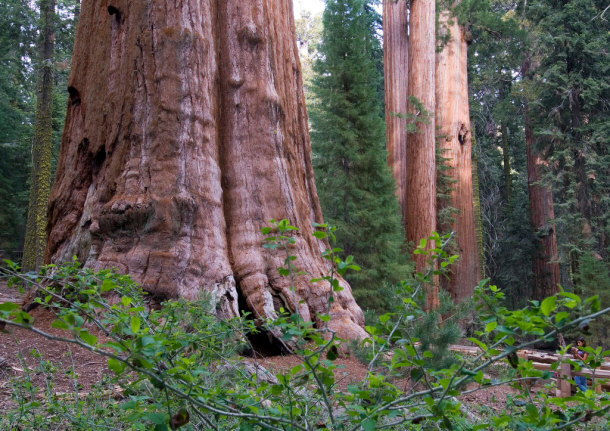
The General Sherman is about 2,500 years old and is about 275 feet tall. The
base of the grand tree is 102 feet in circumference. It was named after the
American Civil War General Sherman, by one of his lieutenants, naturalist James
Wolverton. General Sherman is categorized as a Giant Sequoia species, which are
native specifically to Sierra Nevada, California.
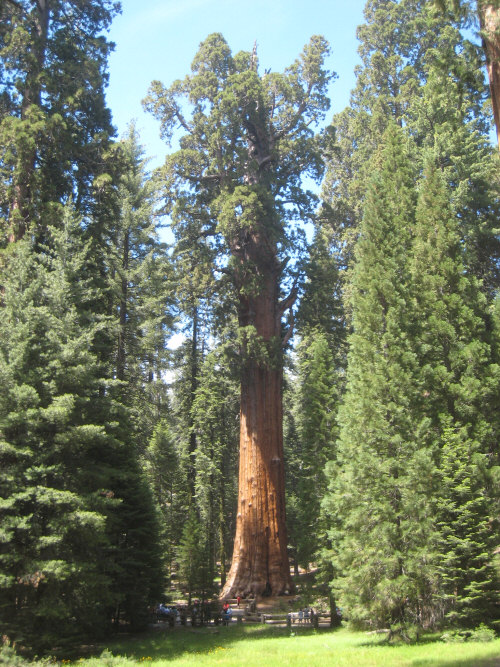
By Chris M
via Wikimedia Commons
6) El Arbo de la Sabina
El Arbo de la Sabina is the name of a famous,
ancient Juniper tree. In Spanish, "Sabina" mean Juniper. Like the famous and
interesting Dragon Tree, it is located on one of the Spanish Canary Islands, El
Hierro. Its species is the Juniper cedrus. The trees are well known for
constantly being deformed by wind. This is how they get their famous deformed
appearance. Although the trunk of the tree stands straight up, the branches
cascade back to the ground.
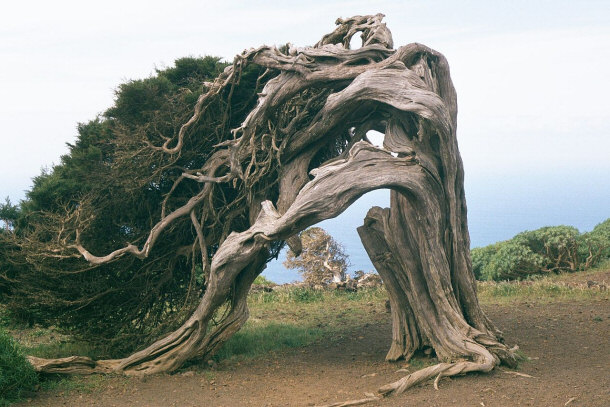
By Eckhard Pecher
via Wikimedia Commons
Since the 1950 it has been a protected tree species. It is classified as
endangered, due to overgrazing by goats and the historical use of the tree's
valuable wood. The trees wood was used to make everything from tables to
torches. Only the deformed branches of the tree remained because the good ones
were used as materials. Now the foliage of the tree grows as though it is a bush
on the ground.
5) Pirangi Cashew Tree
The Pirangi Cashew Tree in northern Brazil is the
largest cashew tree in the world. According to Natal Brazil, the Pirangi Cashew
Tree spans an area of about 78,000 to 90,000 square feet. This translates to
nearly 2 acres – all from one tree. A Brazilian fisherman named Luiz Inacio de
Oliviero planted it in 1888. At the age of 93, Oliviera was found dead sitting
beneath the tree's branches.
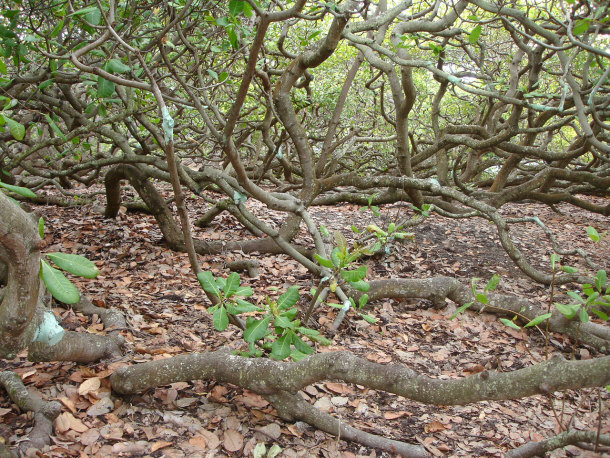
By Edsonaoki
via Wikimedia Commons
The Pirangi Cashew Tree is special because it has two genetic abnormalities.
Most cashew trees grow upward. However, the Pirangi Cashew tree grows sideways,
or outwards. The branches are unable to support their weight when growing
horizontally, so they eventually went downwards to the ground. The second
abnormality happened once the branches hit the ground, they would re-root
themselves there, and begin growing upwards again. Despite appearing like
several small trees, it is actually all one tree. During the cropping season,
the Pirangi Cashew Tree produces about 80,000 cashews. People who visit the park
and the tree are able to pick the nuts off of the branches to eat.
Largest Pirangi Cashew Tree in the World in Rio Grande do Norte, Brazil:
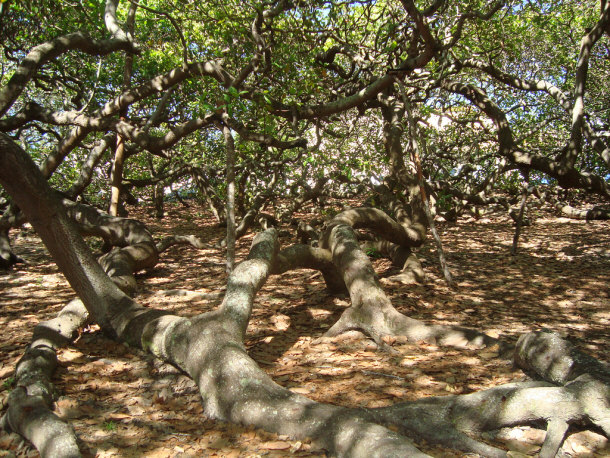
By Mateus S Figueiredo
via Wikimedia Commons
4) The Crooked Forest
In the 1930s, about 400 Pine trees were planted in the Gryfino forest of Northwest Poland. All others species of pines grow straight
upward, as most trees do. However, in the Gryfino forest, all of the pine trees
have grown in an almost identical crooked shape. The trees have grown with a
90-degree curve at the base of their trunks, all of which bend northward.
Nowhere else on Earth does a forest of this abnormal uniformity exist.
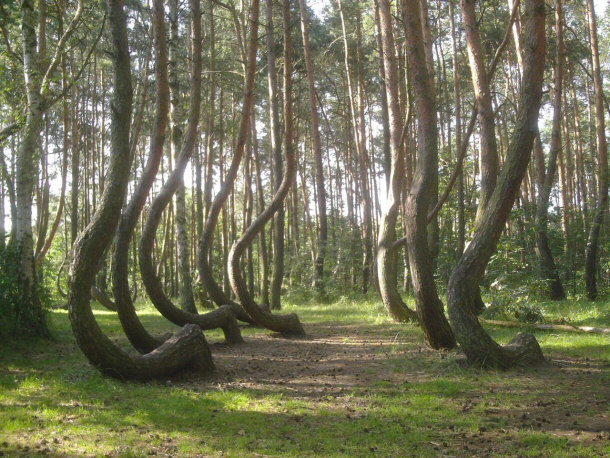
By Asbb
via Wikimedia Commons
The grove was planted just a few years before World War II started. Because
of this, some find it hard to believe that the trees' unique growth is natural.
During the time of plantation, the region was still part of Germany. However,
many people still believe that the unique shape of these pine trees must be the
result of man's intervention, according to Ripley's Believe It Or Not. Some
researchers believe that the reason for this type of crooked Pine was to be used
for specific woodworking projects, like shipbuilding. Regardless, the method of
creating this effect is still unknown to this day. Most likely, it is the result
of formation by human hands, which is a common method of tree shaping. Tree
shaping was also used on the Circus Trees of Gilroy Gardens. Although its uses
vary from art to woodworking, the Pines of Gryfino forest were never cultivated,
and the forest remains a mystery.
3) The Burmis Tree
After most trees die, they begin to show signs of
rotting. However, this is not the case for the Burmis Tree. The Burmis Tree is
located in Alberta, Canada. It is a Limber Pine that lived for 300 years before
it died in the 1970s. The Burmis Tree stands atop a rocky flat along the
Alberta's Crowsnest Pass, nearby the famous mining town of Frank Slide.
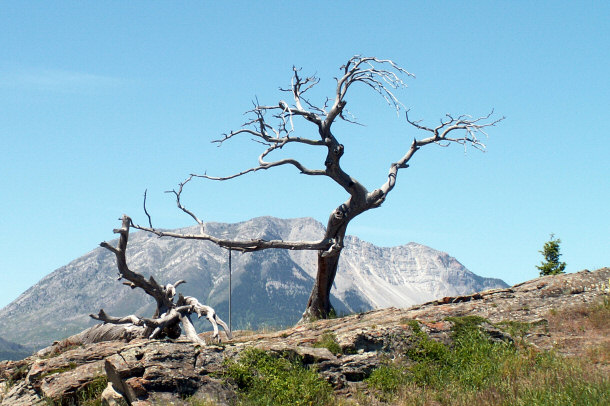
By Monsieur david
via Wikimedia Commons
It is named after the former mining town that once existed in the area,
Burmis, Alberta. Today, the area is a ghost town. The area does serve as a
popular stopping point for people driving on the Highway 3 through the region.
According to Crowsnest Heritage, it is the most photographed tree in Canada. It
also serves as a symbol of the area: that although everything in the area has
died or disappeared, it continues to survive.
2) The Tree of Tenere
The Tree of Tenere is known as the loneliest tree in
the world and is properly called the Abre du Tenere. Many centuries ago, the Tree Tenere was one of hundreds in the
Saharan region. As most of the other Acacia trees died off, the Tree of Tenere
remained alone in the desert. By the early 20th century, it was the lone-plant
growing in the area. No other plant-life existed within the tree's 250 miles
radius. It survived in the Tenere region of the Saharan desert because it grew
within the near-by vicinity of a 40-meter well. The Acacia tree was not
particularly special in appearance. It stood only about 3-meters tall. The tree,
though, served an important function for desert travelers. Because it was a
lonely structure, travelers used it as a landmark for their travels through the
desert. It was the only thing for miles that provided this service.
The Tree of Tenere or Abre du Tenere:

By Michel Mazeau
via Wikimedia Commons
Unfortunately, the Tree of Tenere no longer grows today. In 1973, when the
tree was about 300 years old, it was knocked over by a Libyan driver, who was
allegedly drunk. The Niger National Museum adopted the dead tree. Since then, it
has been replaced by a metal structure that represents the tree.
1) Wollemi Pine Tree
Dinosaurs and creepy crawlers weren't the only things
inhabiting the Earth more than 200 million years. One ancient species of trees
that still exists today is the Wollemi Pine Tree, according to Gardening
Australia. The Wollemi Pine grows to be about 80-130 feet tall, with long leafy
branches, and bark that is dark-brown and knobby. It was first discovered in the
Blue Mountains, about 100 miles west of Sydney, Australia.
Branch of a Young Wollemi Pine (About a Meter Tall):
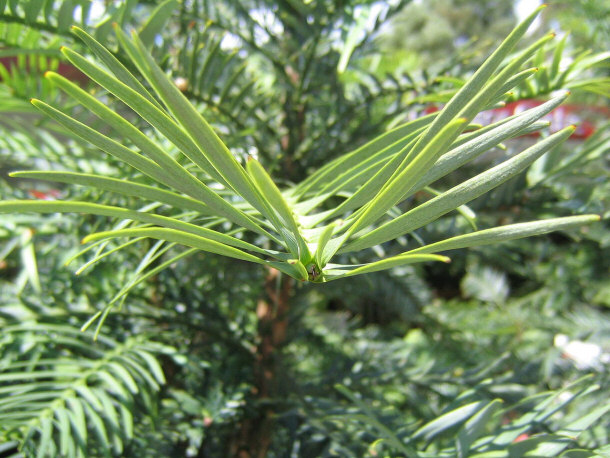
By John Dalton
via Wikimedia Commons
Wollemi trees are not technically pine trees, despite resembling them. They
are a similar ancient species. This was discovered by Wollemi National Park
officer David Nobel in 1994, according to the Australian Botanic Gardens Trust.
Nobel was able to distinguish that, although it as a coniferous tree, like the
pine, it was something entirely different. The Wollemi Pine tree is not a living
species. It is an ancient fossilized Araucariaceae species.
Adult Wollemi Pine:
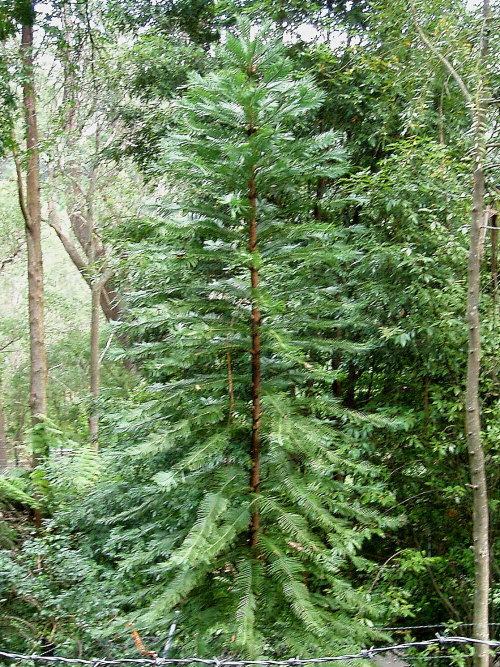
By Amanda Slater
via Wikimedia Commons
The Wollemia noblis,
which was named after Nobel, is the lone surviving member of its species.
Similar Wollemi trees grow throughout Australia, New Zealand, and even
Antarctica. There are thought to be less than 100 of this tree existing today in
the wild. Researchers and botany specialists are keep the precise locations of
the Wollemi pine trees undisclosed, to protect them for damage. They are a very
threatened species.
Wollemi Pine Losing Wax:
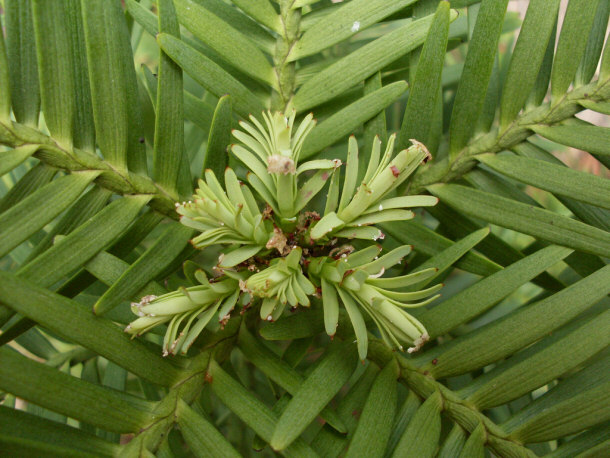
Their conservation status is "critically endangered." It is
important to preserve these plant species' fossils because they are a channel
through which historians and scientists can uncover new discoveries about the
earth's past.
Amazing Trees Are Everywhere
Look around you. Amazing trees exists all over
the world. Some of them are the oldest living things we will ever be able to
adore. The age and grandeur of some trees alone is something to be revered. We
have to appreciate that some of these massive plants have been able to thrive
and survive longer than a thousand years. People rely on trees for so many
things, so there are many reasons to appreciate the trees that do not stand out.
We need trees to breathe clean air, for fuel, timber, and even shade. Some trees
have mystical or spiritual value to their communities, which shows how
magnificent they are. Weird or not, trees of all sizes are something to be
appreciated by mankind.
Nature
Top Lists:
15 Fascinating Facts about the Amazon Rainforest
15 Remarkable Facts About Bacteria
15 Remarkable Facts About Jellyfish
15 Little Known Facts About Elephants
15 Fascinating Facts about Earthquakes
15 Odd And Interesting Facts about Monkeys
Top 15 Myths about Snakes
Top 15 Myths about Horses
Top 15 Creepy Deep Sea Creatures
15 Unexpected Animals That Can Kill You Quickly
Top 15 Spider Myths
15 Beautiful Animals that are Now Extinct
Top 15 Most Amazing Snakes Around the World
15 Fascinating Facts about Snow
Top 15 of the World's Rarest Flowers
10 Most Emotional Animals
15 of the Most Venomous Creatures to Roam the Earth
15 Unusual Animal Defense Mechanisms
15 Unusual and Less Known Uses of Rocks
15 Unique Forest Creatures Less Known To Man
15 Interesting Facts About Time
15 Unknown Parasites You Never Knew Existed
15 Weird Trees Around The World
15 Wild Animals Deadly to Humans
15 Exotic Insects That Are Harmful & Deadly
15 Ridiculous Uses for Gold
Informational:
Preparing for a Disaster
Proof That We Are What We Are!
What is the Meaning of Life?
The Trend and Challenges Facing the Urban World
Creation Narratives and the Evolution Creationist Debate |